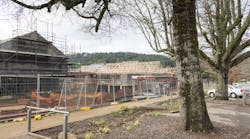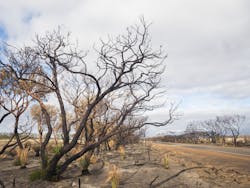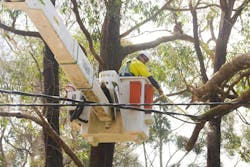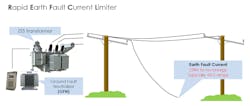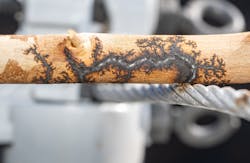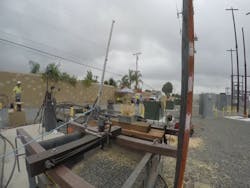It seemed like everything was on fire in 2020 and, at times, that literally was true. In September 2020, my family and I packed up our essentials and prepared to flee the Holiday Farm Fire, a 173,000-acre (70,011-hectare) wildfire fueled by a windstorm and dry conditions that scorched through the McKenzie River area just east of us, threatening our home in Eugene, Oregon, U.S. We were fine, but we did have some new neighbors for a while: two women, two dogs and a cat whose home in Blue River was lost to the blaze.
As I covered the T&D World Wildfire & Risk Mitigation virtual conference in December 2020, I did so with the knowledge firmly in mind of what wildfires can do to a community, but I came away from the experience with a greater appreciation and thankfulness for the engineers, tree trimmers, grid operators, researchers, climatologists and others who work throughout the year to keep everyone safer from deadly wildfires.
A key theme from this year’s conference was West Coast utilities in the U.S. learning from Australian utilities how to manage wildfires with the help of new mitigation tactics and technologies.
Bushfires On The Rise
The virtual conference’s keynote speakers hailed from Australian utilities Powercor and AusNet Services. These utilities oversee the largest part of the Victorian power grid, a combined 75,700 miles (121,827 km) of transmission and 824,000 miles (1.3 million km) of distribution. Australia was hit with unprecedented fires in 2019 and 2020.
Dene Ward, network safety and bushfire mitigation manager at Powercor, set the tone for the show, saying fires will continue to burn hotter and longer. “There’s an underlying caveat: Our organizations don’t have all the answers. We still have our gaps. We will still have fires and, unfortunately, they will still cause community damage,” Ward told the audience during his keynote presentation. “Global warming impacts continue to bite us harder and harder each year.”
Ward said Victoria shares the same challenges as many utilities: an aging infrastructure, rising costs of labor and materials, and regulators who constrain how much they can spend on grid improvements. Amid these challenges, Ward says Australian utilities like his have made great strides with the introduction of new technologies that help to prevent bushfires, as wildfires are called in Australia.
Phil Bryant, manager of network safety at AusNet Services, said climate modeling indicates high fire danger days will continue to increase. “This modeling appears to be self-evident by our actual experience over recent times… The consequences of bushfires in rural areas continue to increase with growing population and development,” Bryant said in his keynote, titled "Lessons from Australia in Wildfire Risk Management."
Tactics And Technologies
Australia’s adoption of wildfire mitigation tactics and technologies can be closely tied to the impact of destructive bushfires and the resulting investigations into them. The most notable of these, Bryant said, was the Black Saturday fires that occurred Feb. 9, 2009, which claimed 173 lives — the majority of which were attributed to blazes sparked by power lines.
“Post-1983 Ash Wednesday bushfires, it was generally accepted that people could stay and try to defend their properties,” Bryant noted. “However, the intensity of the 2009 fires changed this attitude. While it is not compulsory, fire control authorities encouraged evacuations as the safest action.”
The bushfires were different now and more dangerous. The state’s transmission infrastructure, however, has not sparked any significant blazes — unlike that of similar structures on the West Coast of the U.S. “There has been no ignition of bushfires by Victoria’s transmission network and that is something we are keen to maintain through similar approaches to asset management as that applied to our distribution networks,” Bryant explained.
Transmission line maintenance consists of annual line defect patrols backed up by climbing assessments, scoring at multiyear intervals and aerial imaging with a computer algorithm to detect defects. A thermal and corona survey also is done every three years, according to Bryant.
Ward said asset inspection for Powercor consists of on-the-ground inspections plus aerial inspections with drones or helicopters with cameras. “We fly our entire network every year, so annually we’re capturing clearances using LiDAR,” Ward noted. “And a key point is we must maintain our prescribed minimum clearance space at all times of the year, and our safety regulator does hold us accountable to that. They have asset inspectors that go out and do spot audits and serve us notices if they find a tree in a clearance area, which we then have to explain.”
Powercor embarked on a four-year program of installing arm rod and vibration dampers on spans subject to vibration. In doing this, the utility refreshed many pole tops at the same time, fixing tie wires that mount the conductor to the top of the insulators. Ward called this a fringe benefit of the upgrade project that will prevent potential blazes.
Early Fault Detection
Tony Marxsen was the lead researcher in Victoria’s effort to cut wildfire risk from power lines after the Black Saturday fires. He now runs his own consultancy, helping utilities and governments to make their power grids safer. According to Marxsen, early fault detection (EFD) was born out of research done in Melbourne, Australia, which had a wave of pole-top fires. EFD is an internet of things-based system that uses a form of edge processing. Networked data collection units are installed every few miles on poles, and they also can be installed underground. The resulting data is sent by radio signals, and the sensors triangulate the location of the fault.
Marxsen’s presentation showed how this system can detect even strand breaks that are difficult to spot with visual inspections. These are the same kind of broken strands that caused the 1983 Ash Wednesday bushfires, which killed 47 people, he said. Thanks to this system, faults can be found while the grass is still green and harder to ignite.
“A grass fire can rip through this country at 50 mph,” Marxsen explained. Without EFD, crews may not fix the faults in time for the next fire season, or even the next three seasons.
Eric Shoenman, expert operations system engineer at Pacific Gas and Electric Co. (PG&E), talked about bringing this technology to North America in an EFD trial performed by PG&E. The results were as successful as they were in Victoria.
Power lines owned by PG&E were found to be the cause of the deadliest wildfire in California history, the Camp Fire in 2018, which killed at least 85 people. In response, the utility enacted a program of public safety power shutoffs (PSPS), so power lines do not spark wildfires during high-risk conditions.
PG&E tested EFD in Napa Valley, where conductor damage was detected on sections of power lines in a high-risk area. The system identified damage to lines caused by line slap, gunshots and bird caging, as well as vegetation encroachment. “The system is really good at identifying issues, but we are looking at a way to integrate it with some kind of data analytics platform and scale it up,” Shoenman said.
Rapid Earth Fault Current Limiter
PG&E also is testing a rapid earth fault current limiter (REFCL) system at its Calistoga substation before deploying it more broadly. Southern California Edison (SCE), another of California’s big three utilities, also is looking into REFCL.
REFCL is another wildfire prevention application that has its origins down under. REFCL systems were recommended in Australia in 2016 and installed in 45 substations in high-risk bushfire areas, shared Thuan Tran, principal manager at SCE, in his presentation, titled SCE's Approach to Isolating Ground Faults.
In addition to REFCL, Tran said SCE has adopted Australian methods of covered conductor design, vibration dampers and replacement of wood cross arms as part of their fire mitigation program. SCE uses a variant of the REFCL system first used in Victoria.
His presentation showed a high-speed camera recording a simulated power line falling on dry grass. The fully energized lines practically exploded with flames upon contact with the grass, but the falling wire that used the REFCL system had its current compensated in microseconds and did not ignite. Tran said 2014-2016 testing performed by SCE showed a 90% reduction in ignitions from phase-to-ground faults with a REFCL system.
SCE’s final tranche of REFCL installations is slated for 2023, and the full project build-out will cover more than 19,000 miles (30,578 km) of line that crosses high-fire-impact land.
The REFCL systems already installed in Victoria performed well during the 2019-2020 fire season, with a total of 33 ground faults that resulted in no ignitions.
“We definitely could not have got as far as we have without the Australian utilities showing what is possible,” said Jesse Rorabaugh, senior engineer at SCE.
Rorabaugh said he was interested in the technology deployed in Victoria and wondered what could be done to make it work on the SCE system. “What we found was, well, we actually do have a lot of good places to install this technology, but it’s a big installation. It’s expensive. It really only makes a whole lot of sense if you have something that feeds more than about 50 miles of high fire circuitry,” Rorabaugh said, adding that, for some substations, employing a REFCL would require millions of dollars for new cable and transformers.
Cost-Effective Applications
Transformer grounding, on the other hand, shows promise. The ground fault neutralizer builds on resonant grounding and works more like a flexible ac transmission system (FACTS). “It has an inverter and parallel, and it actively controls the neutral and brings the voltage on the fault at phase down to under typically 10 V at the substation bus and brings the fault current down to milliamps,” Rorabaugh explained.
SCE is investigating this technology, which also is used in Australia. However, more options are needed, according to Rorabaugh. “One that looked particularly attractive is, well, instead of converting at the substation bus, why don’t we just convert the high fire part of the circuitry?” Rorabaugh asked. “In a lot of cases, the substation might feed 200 miles of circuitry that’s not high fire and might be expensive to upgrade to this system because of phase-to-neutral connected transformers, but then there’s 5 miles off on the end of one circuit that is high fire.”
This idea looked good on paper, but could it prevent fires? Rorabaugh’s webinar showed it could. The test lines proved the system could reduce ignitions by more than 90%. Thermal cameras revealed the lines that used resonant grounding remained cool enough to touch with a hand — not hot enough to ignite dry grass or a tree branch, or to cause an arc through the air if a line were to strike a guy wire.
Andrew Swisher, consulting engineer at SCE, said in his utility’s 2020 wildfire plan, they identified three different applications and planned to use each in a pilot program in different locations, so the technology could be further refined into cost-effective applications other utilities could use.
Showing a map of the SCE service territory, Swisher said resonant grounded, ground fault neutralizer and individual circuit with isolation transformer could be applied in the areas where each application could perform the strongest and most cost effectively.
By June 2021, SCE aims to deploy the two substation approaches to protect circuits coming out of two substations. The isolation transformer method will be tested in a pilot in 2021.
“This will really be the test bed for how we can further advance these RFCL systems in California on the SCE grid,” Swisher said.
AI Monitoring Systems
San Diego Gas & Electric Co. (SDG&E), the other member of California’s big three utilities that oversees the hottest and driest service territory in the state, is using a network of mountaintop cameras and artificial intelligence (AI) fed monitoring systems to sense when and where wildfire conditions emerge.
Turning to a Google Earth display, Brian D’Agostino, director of fire science and climate adaptation at SDG&E, showed session attendees areas of the utility’s service territory classified as tier one or tier two fire danger. SDG&E gathers live climate information across its service territory, so it can determine how severe the fire risk in an area is in real time. “This helps us understand how the Santa Ana [windstorms] affect the different microclimates we have across a region,” D’Agostino said.
Why is this level of granularity important? Because in the time of PSPS events, a utility can know precisely where power needs to be curtailed or shut off instead of putting entire swaths of service territory in the dark. “What we can do now is, if we saw wind conditions that were a threat just on this one branch of distribution, we could go in and work with system operators to only deenergize that one line,” D’Agostino explained.
D’Agostino added systems like these are being replicated by utilities across California, up into the Pacific Northwest and even in the Midwest and New England. And, in San Diego, the network of climate sensors continues to expand and produce more data.
“All of this weather data has really helped us refine weather models and help us better predict the weather that’s impacting our region,” D’Agostino said. “Not only using traditional weather models, but also using artificial intelligence with all of the data that we’ve collected. That’s now being used to train AI models to help us get very refined and precise with our weather forecasting ability.”
